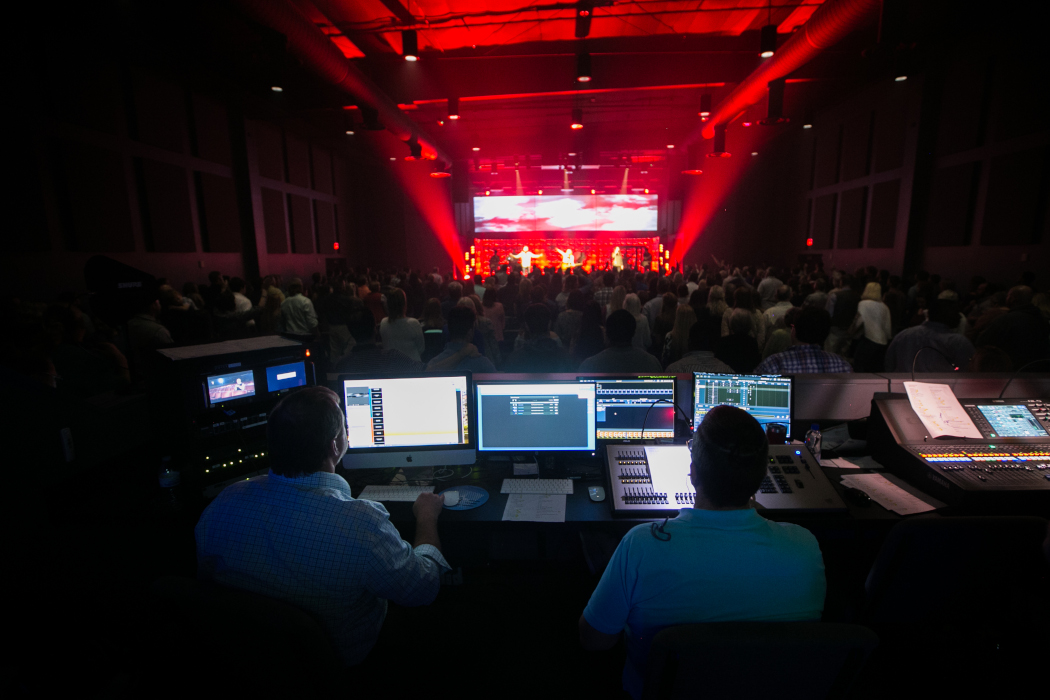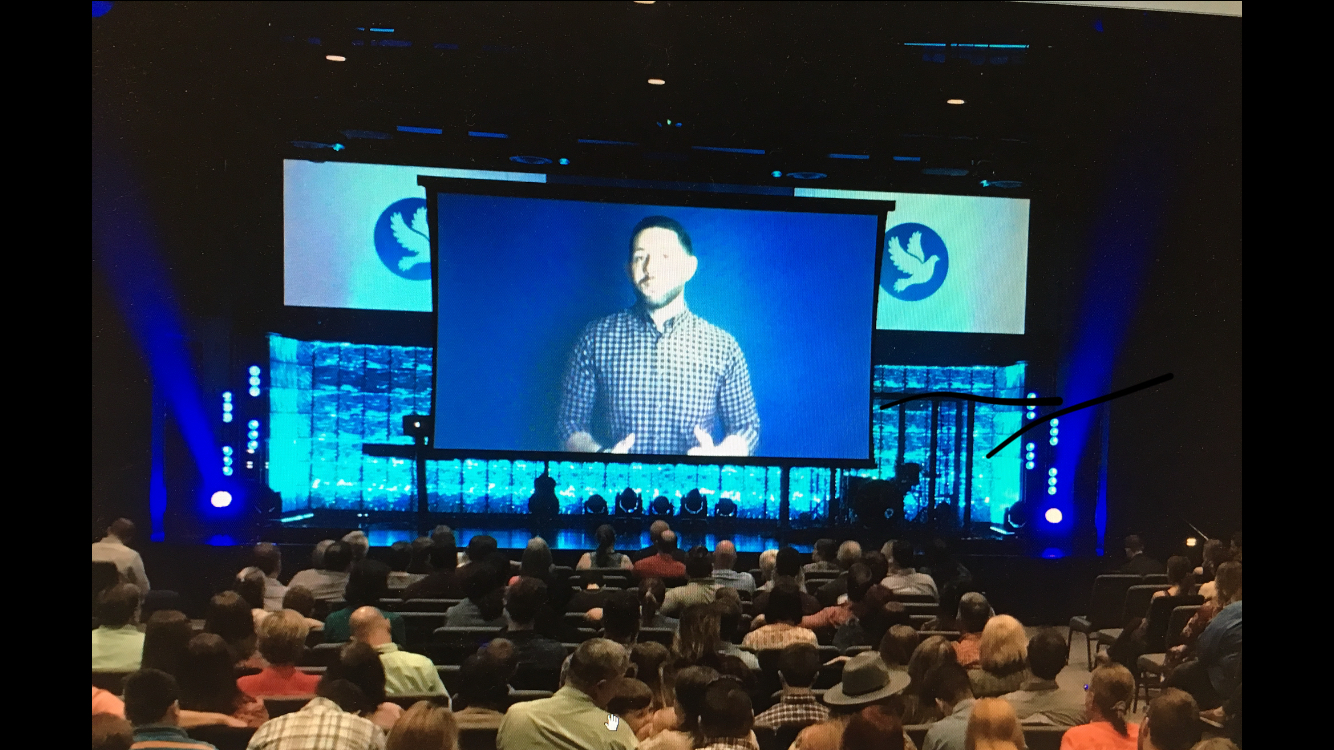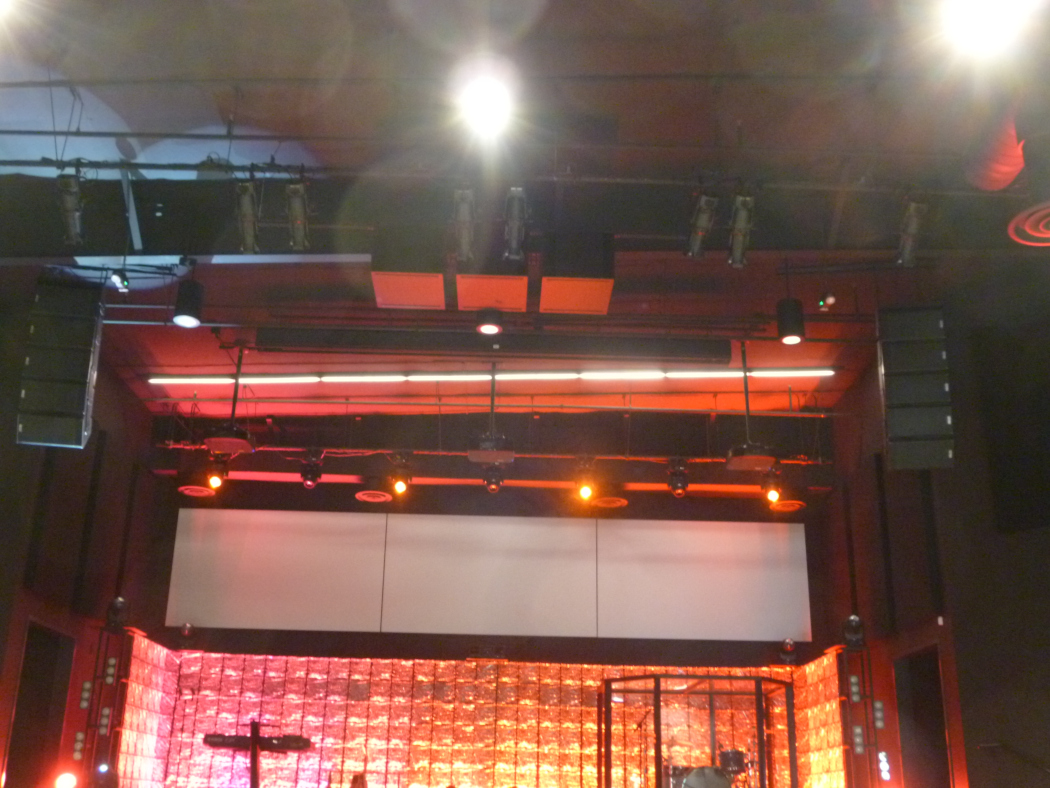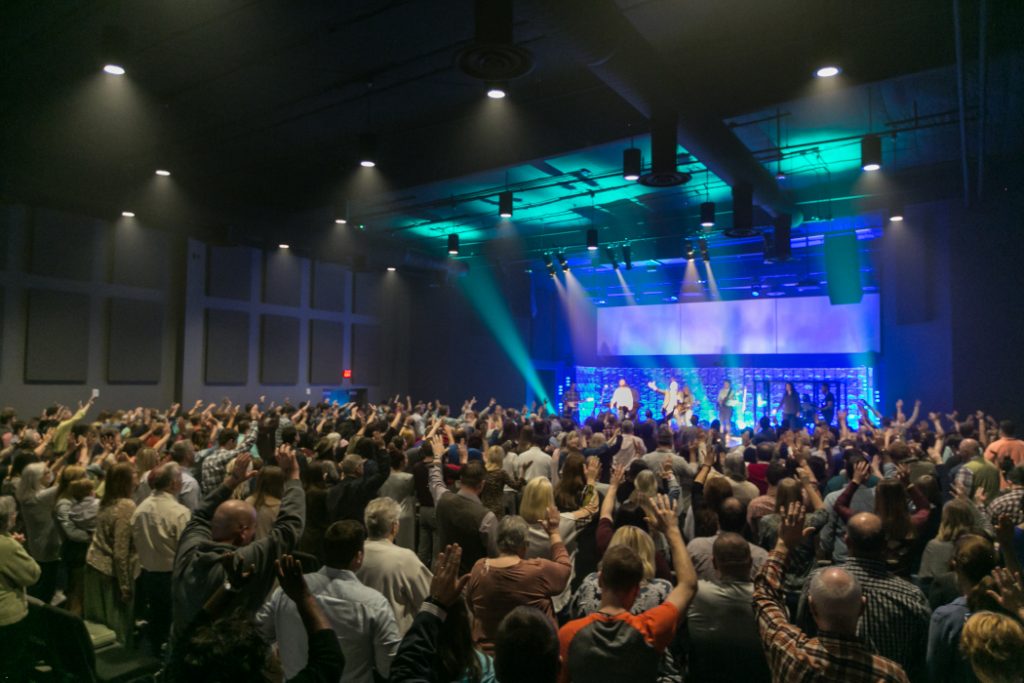Thanks to advances in streaming video, a multisite approach to ministry is now an achievable goal for a growing number of houses of worship. However, as these churches adopt more technologically complex AVL systems in their expansion to multiple locations, they are likely to experience some growing pains. Fortunately, an experienced integrator can help ease its church clients through the initial awkwardness of the transition to a multisite model by setting realistic expectations early in the process and delivering exactly what the client needs to realize these expectations.
Louisiana’s Christ Church is one such house of worship that has adopted a multisite model, and, thanks to its leaders’ clarity of vision and the expertise of integrator American AVL (www.americanavl.com), it recently completed the successful launch of its first satellite location in Ruston LA. The Ruston campus was built to support Christ Church’s existing location in West Monroe LA, which has now been designated as the church’s broadcast campus. The Ruston location was a new construction, built from the ground up for this specific purpose; this meant that the building was designed with its eventual AVL needs in mind.
In terms of its design, Christ Church Ruston is more or less your prototypical modern worship space. “It’s pretty much a giant box building with a blacked-out ceiling and a stage area,” R. Gwin Edwards, President of American AVL, described.
“The lobbies are contemporary rustic style. It’s an L-shaped building. There is a wing of classrooms and offices, and then the worship center is the other wing. Seating [in the main sanctuary] is all flexible seating—lockable chairs, but it’s totally flexible.”
Christ Church’s services open with an introductory video segment, followed by a musical performance by a contemporary worship band, which is followed by a spoken-word sermon. The Ruston campus has its own dedicated band that performs at the venue each week, but the spoken-word sermon is delivered live and in person at the West Monroe campus and streamed (nearly in real time) at the Ruston campus.
Christ Church wanted to ensure that the Ruston campus would be able to support its musical performers with high-end audio and theatrical lighting, but the streaming video setup received the lion’s share of attention in the design process. “Our main concern was the quality and consistency of the video feed we would be broadcasting every week,” Ryan Lowe, Christ Church’s Executive Pastor of Ministries, said. “We looked at many other churches for technical and service flow inspiration.”
American AVL had previously installed systems at the West Monroe campus, and because Edwards is a member of Christ Church’s congregation and American AVL’s main office is located just around the corner from the Ruston location, the company was Christ Church’s first pick to design the audio, video and lighting systems for the new campus. Christ Church’s leadership reached out to American AVL early in the build process for the new building, which allowed the integrator to work closely with building contractors to ensure an optimal setup for the AVL systems.
“It was actually a very good deal,” Edwards recalled. “One of the compromises they were looking at to save money was lowering the roof heights, which lowered everything inside the building. So, we literally had to specify duct heights down to the inch to make sure they weren’t blocking speakers or lights or whatever, and then of course we had to follow up on that during construction. So, it was good that we were in early to get all that specified. We were able to be very specific, and of course get power, conduit and cooling units where we needed them.” He added, “The original plan had rooftop air conditioners on top of the sanctuary, and we knew that was a bad idea because of the noise, so we were able to get them moved off the main roof and onto a side roof. That made a huge difference.”
Another positive for Edwards’ team was that the church already had a solid vision for the worship experience in the satellite campus and had done some research into what technology they would need to make this vision a reality. “The church actually had a really good idea what they wanted to do,” Edwards said. “When they started looking at satellite campuses, they went to other, much larger churches and tried to figure out what not to do, but also what worked for those churches. One of the bigger ones they tried to emulate was the Church of the Highlands in Birmingham [AL]. So, they had a really specific idea—‘This is the look we want; we want three screens here; we want a big screen in front; this is the level of lighting production….’ Specifically, they gave me a picture of one of [Church of the Highlands’] satellite churches, the screen setup and so forth, and they said, ‘This is what we want it to look like. How do we get to this point?’”
True to this initial vision, the Ruston campus’ stage is dominated by three fixed 159-inch Da-Lite UTB Contour Screens, which are used as a backdrop for the stage. Content is fed to these three screens via three Epson PRO L1405UNL 8,000-lumen laser projectors. An Apple iMac running ProPresenter is used to send the content to the projectors, and a Matrox TripleHead2Go multi-display adapter is used to split the content onto the three screens. All content for these screens is created in-house at the West Monroe campus.

When the time comes for the spoken-word portion of the service at Ruston, a 220-inch Da-Lite 29453G screen housed in a Wireline Advantage descending case is lowered in front of the three fixed projection screens. (The screen is actually lowered during a dedicated “meet-and-greet” time, which takes place immediately before the main sermon.) The sermon is recorded at the West Monroe campus using Panasonic AK-HC3800 HD 2/3-inch-chip cameras, which were purchased specifically for streaming video to the Ruston campus. The recorded sermon is then streamed on the large central screen at the Ruston campus. “It’s done on a very tight timeline, so that there’s literally no more than a second gap between anything local and the streamed portion of [the service],” Edwards said.
The central screen is fed content by an Epson PRO L1505UNL 12,000-lumen laser projector, which is mounted behind the screen location; the screen’s Dual Vision surface allows this rear-projection setup. The Ruston campus relies on a Haivision Connect DVR cloud-based system to manage the incoming delayed video stream from the West Monroe campus. The DVR/matrix system is the centerpiece of the FOH video distribution system, which is also used to send the spoken-word sermon video to a number of displays located throughout the building.
“Everything is sent over HDBaseT from our front-of-house rack,” Edwards explained. “We have an Extron [DXP 88 HD 4K] matrix system, so we can route any source to any screen. Most of the video system is controlled by an Extron [TLC Pro 521M] touchpanel control. It has a custom GUI setup where we can power the screens up or down, mute them if something goes wonky and try to simplify [control].” The custom GUI was programmed by American AVL. “We’ve just found we have a lot less service calls and a lot less failures with [a custom GUI] in place as opposed to just using the remote that comes with the projector and screen,” Edwards said. “Even if you put a repeater in, invariably it’s going to fail because the eyelet falls off, or somebody points it the wrong way or whatever. But if you’re on an IP-based control, it’s going to work the majority of the time.”
There are four total 70-inch Sharp displays in various locations (one in the main lobby, one used as a confidence monitor hung opposite the main sanctuary stage and two in the children’s area, which is a separate wing of the building divided into smaller rooms dedicated to youth ministry and childcare during services). Two 60-inch Sharp displays are located in the atrium area, which is used for overflow seating and as an improvised cry room. In addition, several 49-inch LG displays are installed in the musician’s green room and various rooms in the children’s area.
A Drake DSE 2 Plus HD encoder and DRACOM DDA5542R distribution amplifier are used to extend the video signal to the children’s area, whereas the lobby and atrium receive their signals via an HDMI-over-UTP system. “The Drakes are used for auxiliary or secondary feeds that we run to the kids’ areas where we’re not as concerned with the signal being exactly in time with PA,” Edwards shared. “Because that type of encoder has an inherent delay to it, they’re a few seconds behind the sanctuary, but it’s a much cheaper option than a point-to-point. So, we use that solution for those areas that don’t have the sanctuary as a reference. The lobby and the atrium, we have those on an HDMI-over-IP-type transmitter system, so it’s instant, in sync.”
On the audio end, Christ Church Ruston’s approach is fairly typical of the contemporary worship style. “Our Ruston campus typically uses an eight-piece band: keys, bass, drums, two electrics, one acoustic/singer and two additional vocalists,” Lowe said. “Worship is a huge part of what we do, and we put just as much energy into the worship aspect as we do everything else. We want worship to be fun, engaging [and] high energy, but most importantly, authentic.”
In the early stages of the project, Edwards and his team did some acoustic modeling of the worship space and identified a few problem areas that could benefit from acoustic treatment. “It’s a gigantic rectangle, a long skinny room, so there were tremendous flutter echoes in the bare building,” Edwards said. “So, we put in a set of staggered acoustical panels throughout the room. Also, the room being small and it being a very vibrant service, the volume in there can overwhelm you, so we wanted to make sure we had enough absorption in the low frequencies. So, we have a little bit thicker panels than most rooms this size. They’re three- or four-inch-thick panels to help take care of the low end.”
Edwards continued, “There are a lot of rows really close to the stage. The drummer, even though he’s in a glass cage with a roof on it, you can still hear him acoustically a bit. So, we did have some acoustical panels added to the stage walls to help deaden the initial sound and stop some of the noise from the stage, and even from the moving lights. The room’s small enough that with 30 moving lights on, it can get pretty noisy in there.”
The back wall opposite the stage also needed some treatment to reduce reflections in the space. “The back wall was really the problem area, which is usually the big problem area in rooms,” Edwards said. “This one was extra problematic because there had been some modifications to the back wall from the original plans. We had to tweak the size of the panels and the location quite a bit to make them fit there but still cover the wall and not look like a hodgepodge.” All the acoustic panels were made by Purdue Acoustics.
For the Ruston campus’ audio system, Christ Church wanted something similar to the audio system in use at the West Monroe campus. “The mandate from the church leadership was that this campus needed to be a smaller version of the West Monroe campus,” Edwards said. “They didn’t want it to be a night-and-day difference if they had to bring operators, or musicians for that matter, from the other campus. They wanted them to feel in place.”
For the main mixing console, American AVL specified a Yamaha QL5, which is located at front of house. “The main campus still runs an M7CL, so the QL5 was one of the affordable options that we had available. The software and the controls are very similar,” Edwards said. “On the console itself, as far as operation, we pretty much run off one preset during the entire event. There are some things built in—many different EQ settings for different singers and pastors that we can pop in, as needed. The singers tend to rotate each week, so we’ll pull in different processing for them. We’ll have a baseline preset, and then we’ll just alter that slightly each week based on who’s changed out that week.” A Yamaha Rio 32×24 stage box is used for stage inputs, and it sends the audio signals to the mixing console via Dante.

A pair of Yamaha NEXO line arrays is flown left and right above the stage. Each array is comprised of five NEXO GEO-S1210/30 cabinets. “There are four long-throw speakers and one short-throw on each of the arrays,” Edwards said. “The NEXO arrays, we’ve used them on several other jobs. It’s not one of the esoteric line arrays, but for the money you pay for it, it has an incredibly good sound. And with their modeling software, we’re able to get an extremely accurate picture of the room at all frequency bands before we set foot in the room.”
The low-end audio is handled by three NEXO LS18 subs, which are flown above the center of the stage, between the arrays. American AVL had to tweak the beam steering on the subs a bit after the initial sound tests. “We did that because one of the complaints we had from our neighbors—which is my office—when they were testing was that they could hear the subs a hundred yards away from the building,” Edwards recalled. “So, we tried to collapse that wave a little bit so that it focused a little bit more narrowly in the room, which also helped take some of the low-frequency energy away from the nursery and kids areas.”
An additional three NEXO ID24T speakers are used as front fills for the first few rows of seating. “There’s basically one left, center and right,” Edwards described. “For each of the seating banks, you have a speaker between you and the stage, so you’re not overwhelmed with the sound being 18 feet above you.”
The building’s distributed audio system includes six JBL Control 25-1 wallmount speakers and two JBL Control 26 DT ceiling speakers, which are located in the hallways, as well as two Frazier CAT499 wall-mount speakers, which are located in the atrium. These speakers reproduce the sound from the main sanctuary throughout the building.
An additional three JBL Control 29AV1 outdoor speakers are located on the external walls of the building between the main entrance and the parking lot. These outdoor speakers are independent from the main sanctuary audio system, and are used to play ambient music, which is fed from a Denon DN-300Z.
The Ruston campus features a dedicated amp room just off the main stage that houses all the amplifiers. A NEXO NXAMP4x4 is used to power the line arrays, whereas a NEXO NXAMP4x1 is used to power the front fills. A pair of Crown CDi1000 amps powers the speakers in the hallways and atrium, as well as the outdoor speakers. The amp room also contains a sound-control closet for housing the guitar amps, which are fed by two Radial Engineering SGI studio guitar interface modules. The guitars are mic’d onstage using two Sennheiser E609 guitar amp mics.
The audio signals are fed into a BSS Audio BLU-100 digital signal processor with a Dante bridge to BLU link. “We have pretty much the entire system dialed in in the BSS,” Edwards said. “The NEXO amps have their speaker tunings built in, which gets them to a good starting point, and then we’ll do some adjustment for the room modes, delays, etc. We do all that in the BSS.” He added, “The BSS also allows us to do some of the audio routing. That’s how we discreetly route music to outdoor versus indoor. We actually have a [BSS EC-4B preset controller] with a push button at the front of house that’s just really simple.” The preset controller has two presets for routing signals to the distributed audio system; one sends ambient music and another sends the signal from the mixing console.
Onstage, the vocalists use Shure PSM 300 personal wireless monitor systems, whereas the instrumentalists use Aviom A320 personal mixers. In addition to the Rio box, instrument inputs include a Sennheiser E600 drum mic package, the aforementioned guitar amp mics and two Whirlwind IMP-2 direct boxes for keyboards. Three ACE floor boxes and a number of custom XLR patch panels are used for additional inputs and improvised signal routing, as needed.

The vocalists use Shure QLXD wireless mics with KSM9 heads, and a Countryman headset is available should the need arise for a locally delivered sermon. A Shure GLXD wireless system is used by one of the band members to relay stage directions and cues to the other performers onstage, as well as front of house.
The lighting system is controlled via an ETC Element 60-500 console with two DMX universes. The main sanctuary contains all LED fixtures by Chauvet, ETC and Martin, including 26 movers and 33 fixed lights, plus an Antari HZ-400 hazer.
“The front-of-house lighting for the vocalists is primarily non-colored light or white light using ellipsoids at locked-down positions forward to the stage,” Edwards described. “There are a few color lights just above the front of the stage. Most of the lighting is actually done from the back or sides of the stage. We have strip lights or linear lights surrounding the stage that are uplighting the backdrop. We also have a set of movable lights scattered all over the place, either on the floor or at the top of our set, so we’re able to do patterned, colored head movement with those. We also use quite heavily the nine movers above the back of the band or back of the set for a tremendous amount of lighting effects through the room. We are running a hazer with oil-based fluid a lot during music times, so we can create beams and patterns throughout the room.”
Edwards added, “We’re not trying not to ‘shock’ people, but just get effects going on above their heads or up on the ceiling to create some excitement and vibrancy. And, of course, the lighting changes with the tempo of the music. A typical song will have a minimum of six lighting cues, and we can have 10 or 12 cues on some songs. Every cue is scripted based on the song and mood that they’re trying to create.”
The AVL system at the Ruston campus is typically run by a head technician leading a team of volunteers. “We have one paid team member onsite every week who has the most knowledge about the system we use to stream the service,” Lowe said. “There are typically four people managing the AVL at the Ruston campus, three of which are volunteers, and their expertise varies.”
Because Edwards attends services at the Ruston campus, he often oversees the operation of the system, and he participated in training the volunteers on the use of the various components. “An IT person is also at the Ruston campus every weekend to watch the network traffic and verify the DVR stream is loading properly,” Edwards said. “He also stays in communication with the West Monroe campus video team during the stream to try to adjust or correct any issues quickly. But his day job is working in the West Monroe campus during the week, managing IT and various media-related things.”
Christ Church’s reaction to the completed system was extremely positive, and Lowe awarded American AVL “five stars” for their service. “We are thrilled with the system,” he shared. “If anything, our broadcast campus is a little envious of all the great gear our Ruston campus gets to use weekly.”
